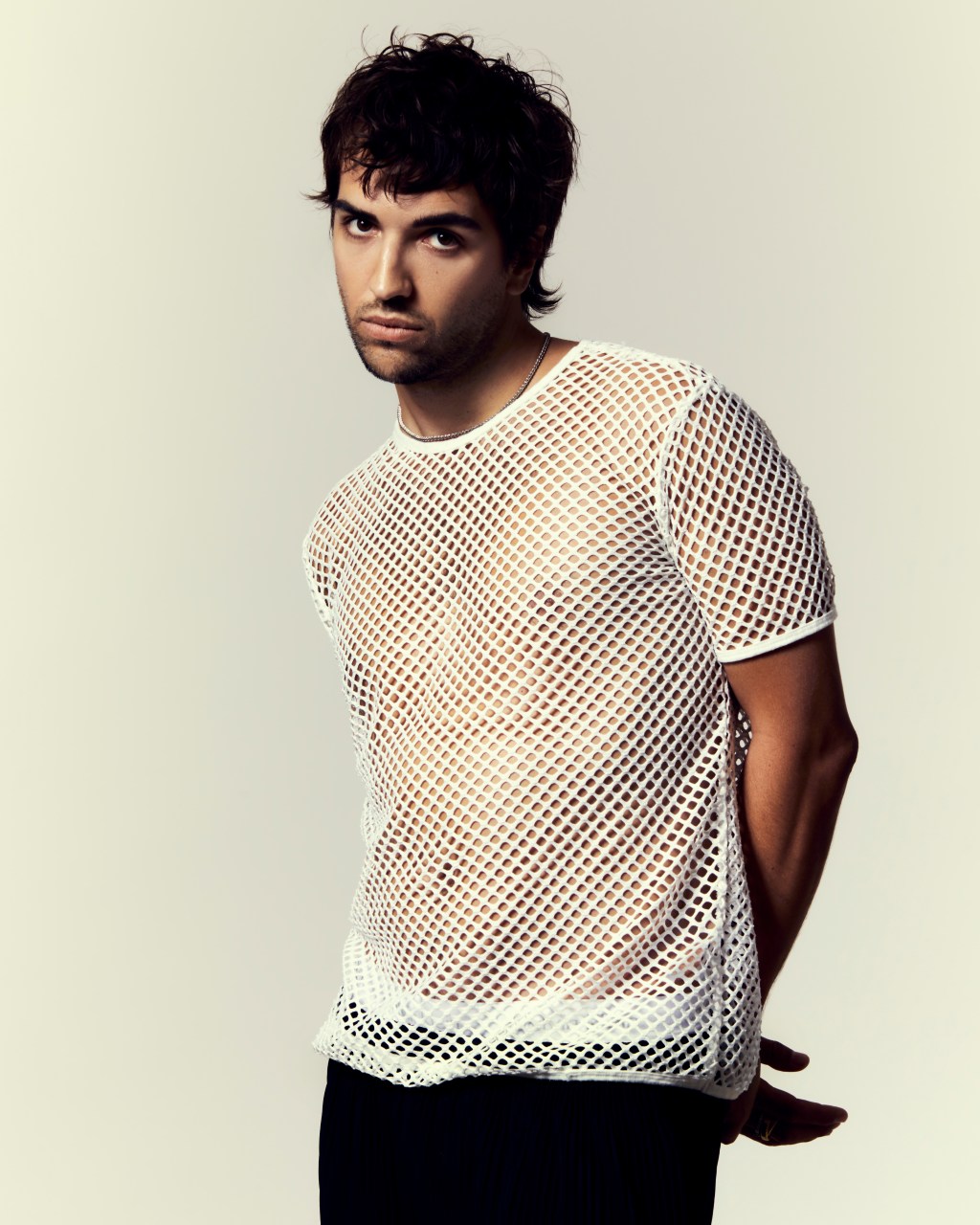MILAN — In the showroom, construction workers were setting up the lighting for the show, a separate entrance was congested by delivery men coming and going with boxes, while in the room next door the press office staff was typing undaunted on keyboards. Yet sitting on the couch of Giuliano Calza’s own office at GCDS headquarters here, one felt isolated from all the usual pre-show rituals and their frenzy.
What was meant to be a brief preview of a collection turned into an hour-long conversation going way beyond clothes, extending to an analysis of the state of Italy, how political correctness affects creativity, and a quick observation on Gen Zers’ attitude toward work.
It speaks loudly of the distorted perception dictated by social media. Calza’s posts on Instagram might sell the frivolous life of a young designer via selfies, parties and buddy activities with BFF Dua Lipa, giving to many of his followers the impression he happened into fashion almost by chance. But Naples-born Calza has multiple degrees — ranging from political science to economics; lived in China; travelled the world, and most importantly, developed critical thinking before establishing a company in 2015 that with its pop and bold universe secured an investment by private equity firm Made in Italy Fund at the end of 2020.
Now, after detours into outlandish, cartoonish and flashy creative worlds with collections nodding to Dracula or filled with references to SpongeBob SquarePants or pink, alien-shaped mascots, the designer is ready to serve up a homecoming experience with a Mediterranean-inspired spring 2024 coed lineup.
“I got a little nostalgic… When I first started this collection, I asked myself: What is home to me? Of course it’s Naples, but it is also a memory. So how do I re-elaborate a memory?” said Calza.
Pragmatically, he relied on pastel hues versus his usual popping colors, as well as on contrasts, offering “good boys from bad neighborhoods” looks via striped polo shirts with piercing embellishments on collars and teeny tiny jersey separates scattered with studs for women. Elsewhere, denim mingled with bourgeois tweeds, while preppy touches came via knits, shirting and loafers to wear with white socks.
The handwoven wicker chairs in Naples’ alleys were turned into a monogram pattern on “sexy silhouettes that fit more a pop star rather than an old lady,” such as knee-high platform boots, or in raffia mules with a new logoed kitten heel.
“This time the creative process has been less chaotic, more organized. I really thought: Which are my memories? I remember that hideous mahogany furniture in the kitchens of Naples, or the yellow and light blue tiles in Positano,” said Calza, pointing to how the former was translated into a new rendition of the brand’s old-school telephone-shaped bag and the latter informed the overall color palette of the collection.
“The point was to make special what for us [Italians] is normal, so silhouettes are really simple,” he continued, while showing one of the most eye-catching pieces: a gown made of a black bodysuit covered in shimmering silver fabric to mimic “when you wrap a towel around your body, something à-la-Sophia Loren.”
To escape the trap of turning Italian references into clichés, Calza underscored that his exercise consisted in translating them into pop imagery, rather than vintage ones. “It’s a sort of ‘Made in Italy, but make it viral.’ It can’t be the usual image that has been always reiterated in communication over and over again. It’s important that the past lives in the present, even if it is way more difficult to sell… But there’s no point in selling merchandising of something that already exists, like a lemon print that in Positano you can find in every home.”
The designer’s goal is “to make the good things of Italy digestible for my generation” by changing them and making them cool. In general, Calza believes this process is the most difficult to find nowadays “because we live in a moment of cultural stalemate, which we could call the era of remixes. Everything is a re-edition rather than an elaboration, from music to movies.”
Speaking of music, in another throwback move the soundtrack of the show will center on Italo-disco artist Pino D’Angiò. To be held on Thursday at 8 p.m. CET, the runway event is expected to drift away from the excessive formats of previous seasons, too.
“We looked at the schedule and there was Sabato De Sarno, who is a dear friend, and his debut at Gucci, which will be fireworks; Prada; Tom Ford; [many] new designers… Plus last season we staged our most successful show in terms of location, stars attending and so on. So I thought: either I become Philipp Plein, going for bigger and bigger shows, or I do something that I really feel like doing,” said Calza about the choice of staging the event at the brand’s headquarters.
The move implied a more intimate venue, with capacity reduced from 700 guests to roughly 250 attendees, and a setup recalling the atelier presentations of yore, aimed at putting the focus back on garments rather than the spectacle. In addition, Calza aimed to offer a glimpse of GCDS’ daily world to his guests.
“We will stage the photocall by the coffee machines at the entrance, the show in the showroom where we actually sell the collection, passing through the offices. People often ask me, ‘Where are you based?’ Here’s the answer,” he said. “I think that showing the place where everything happens [is key] to make a brand like mine not easily replaceable.”
In Calza’s plans, it will also help him to communicate to a younger audience that there’s substance behind a logo.

“I believe that the new generation thinks that all it takes to launch a brand is doing T-shirts and putting them on TikTok. But education is key. I have three degrees and used none, but in truth I used them all in this job. I did everything for it and to make this business work, starting from packing boxes,” said Calza. “This should be the message coming from a popular brand, otherwise people will think everything happens just like that, that becoming a designer is like winning the lottery. And you know what makes me the maddest? Not those insulting me for being ugly or gay or whatever. Those saying, ‘oh, I wish I was born like you.’ No, you grow up into me.”
As for Naples, the city has experienced a renaissance moment over the past year, with booming tourism and attractiveness boosted by pop culture via successful local TV series and accomplishments sport-wise, like the historic win of the S.S.C. Napoli soccer club of the Serie A championship after more than 30 years.
“When I used to say I was from Naples, people almost pitied me. Now it seems it has become the center of the world,” said Calza. Yet he stressed that the idea of the collection comes from an overall nostalgia for Italy, especially felt when he was abroad.
“When I used to live in China, I dreamt of returning to Milan, to go to the bakery or drink a spritz. All stupid things, but when you are abroad you realize the richness we have, and that unfortunately for political reasons we don’t value but take for granted. Or worse, we consider life abroad to be always better and we want to run away,” he said.
“Same goes for the cultural richness we have in our DNA and can’t communicate. Americans are better in the marketing and have bigger budgets, French people know how to build a system… meanwhile they are referencing our artists or buying our companies,” he continued, pointing as example the recent burst of interest in Gaetano Pesce, propelled by Matthieu Blazy at Bottega Veneta.
Calza’s solution is to “reprise to do our own thing and return to what made us big in the first place, which is again education and culture. If we lack education, empathy and our innate sentimentalism, this country is headed to failure,” said the designer, urging also for the government’s support for local companies.
“We’ve being acquired piece by piece, and [the political class] is doing nothing. Also Mr. [Giorgio] Armani, who said that he will never sell the company to French players. Good, but then do something, create a group yourself… I hope one day I will have so much money that I will be able to buy and back Italian young brands, as well as suppliers like button-makers,” said Calza.
Yet the designer feels the moment of teamwork has passed. “We’ve lost that cultural momentum, because there’s no exchange anymore. We’re all on our phones, and everybody can say anything, but there are no real voices. Who are the intellectuals and wise people of this historic moment? Everybody has a voice, but not all voices are right,” he said.
In the white noise he addressed, Calza also underscored how political correctness is “becoming a gag” for creativity. He pointed to, as the most recent example, the new GCDS advertising campaign released earlier this month, which teased this back-to-the-roots approach with Neapolitan references.

“We posted a video of a naked woman with a bag, and people said it was objectifying the body while for me it was celebrating it. Another clip showed an octopus getting out of a bucket and returning to the sea and it was criticized for using animals as props… you can’t use anything. Even those who could spark ideas, like creatives, artists, designers… they can’t use anything… The risk is that there will be no more expression, because most of the times art, poetry, cinema are provocations. Otherwise we will continue to watch only Marvel movies, where nothing really happens,” said Calza.
Again, he said the issue is mainly cultural. “My biggest problem in creating is taking for granted things that for me are normal without taking into consideration some people’s ignorance, that is much stronger. And also — lightness. Especially at the beginning, I was super fun, I wanted to entertain. That was the role of fashion for me, not a political one,” he concluded.




